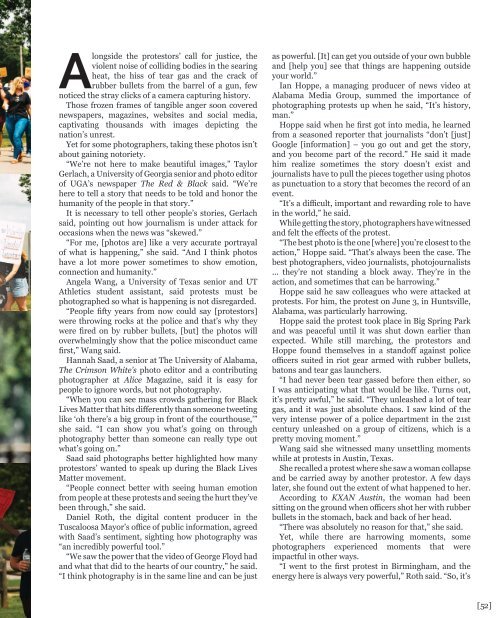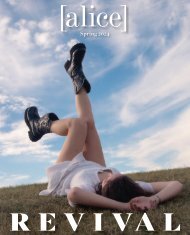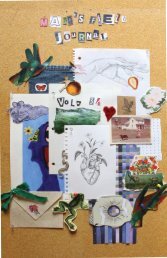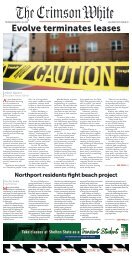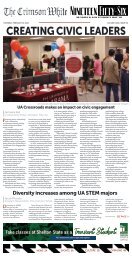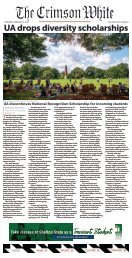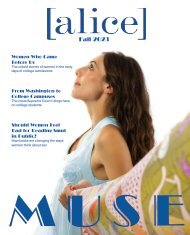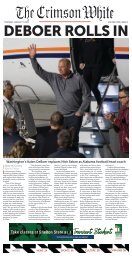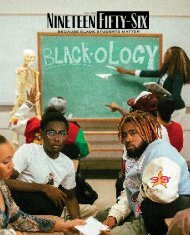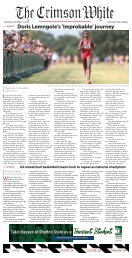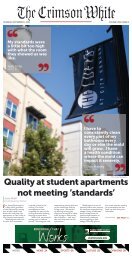Alice Vol. 6 No. 1
Published by UA Student Media Summer 2020.
Published by UA Student Media Summer 2020.
Create successful ePaper yourself
Turn your PDF publications into a flip-book with our unique Google optimized e-Paper software.
Alongside the protestors’ call for justice, the<br />
violent noise of colliding bodies in the searing<br />
heat, the hiss of tear gas and the crack of<br />
rubber bullets from the barrel of a gun, few<br />
noticed the stray clicks of a camera capturing history.<br />
Those frozen frames of tangible anger soon covered<br />
newspapers, magazines, websites and social media,<br />
captivating thousands with images depicting the<br />
nation’s unrest.<br />
Yet for some photographers, taking these photos isn’t<br />
about gaining notoriety.<br />
“We’re not here to make beautiful images,” Taylor<br />
Gerlach, a University of Georgia senior and photo editor<br />
of UGA’s newspaper The Red & Black said. “We’re<br />
here to tell a story that needs to be told and honor the<br />
humanity of the people in that story.”<br />
It is necessary to tell other people’s stories, Gerlach<br />
said, pointing out how journalism is under attack for<br />
occasions when the news was “skewed.”<br />
“For me, [photos are] like a very accurate portrayal<br />
of what is happening,” she said. “And I think photos<br />
have a lot more power sometimes to show emotion,<br />
connection and humanity.”<br />
Angela Wang, a University of Texas senior and UT<br />
Athletics student assistant, said protests must be<br />
photographed so what is happening is not disregarded.<br />
“People fifty years from now could say [protestors]<br />
were throwing rocks at the police and that’s why they<br />
were fired on by rubber bullets, [but] the photos will<br />
overwhelmingly show that the police misconduct came<br />
first,” Wang said.<br />
Hannah Saad, a senior at The University of Alabama,<br />
The Crimson White’s photo editor and a contributing<br />
photographer at <strong>Alice</strong> Magazine, said it is easy for<br />
people to ignore words, but not photography.<br />
“When you can see mass crowds gathering for Black<br />
Lives Matter that hits differently than someone tweeting<br />
like ‘oh there’s a big group in front of the courthouse,’”<br />
she said. “I can show you what’s going on through<br />
photography better than someone can really type out<br />
what’s going on.”<br />
Saad said photographs better highlighted how many<br />
protestors’ wanted to speak up during the Black Lives<br />
Matter movement.<br />
“People connect better with seeing human emotion<br />
from people at these protests and seeing the hurt they’ve<br />
been through,” she said.<br />
Daniel Roth, the digital content producer in the<br />
Tuscaloosa Mayor’s office of public information, agreed<br />
with Saad’s sentiment, sighting how photography was<br />
“an incredibly powerful tool.”<br />
“We saw the power that the video of George Floyd had<br />
and what that did to the hearts of our country,” he said.<br />
“I think photography is in the same line and can be just<br />
as powerful. [It] can get you outside of your own bubble<br />
and [help you] see that things are happening outside<br />
your world.”<br />
Ian Hoppe, a managing producer of news video at<br />
Alabama Media Group, summed the importance of<br />
photographing protests up when he said, “It’s history,<br />
man.”<br />
Hoppe said when he first got into media, he learned<br />
from a seasoned reporter that journalists “don’t [just]<br />
Google [information] – you go out and get the story,<br />
and you become part of the record.” He said it made<br />
him realize sometimes the story doesn’t exist and<br />
journalists have to pull the pieces together using photos<br />
as punctuation to a story that becomes the record of an<br />
event.<br />
“It’s a difficult, important and rewarding role to have<br />
in the world,” he said.<br />
While getting the story, photographers have witnessed<br />
and felt the effects of the protest.<br />
“The best photo is the one [where] you’re closest to the<br />
action,” Hoppe said. “That’s always been the case. The<br />
best photographers, video journalists, photojournalists<br />
... they’re not standing a block away. They’re in the<br />
action, and sometimes that can be harrowing.”<br />
Hoppe said he saw colleagues who were attacked at<br />
protests. For him, the protest on June 3, in Huntsville,<br />
Alabama, was particularly harrowing.<br />
Hoppe said the protest took place in Big Spring Park<br />
and was peaceful until it was shut down earlier than<br />
expected. While still marching, the protestors and<br />
Hoppe found themselves in a standoff against police<br />
officers suited in riot gear armed with rubber bullets,<br />
batons and tear gas launchers.<br />
“I had never been tear gassed before then either, so<br />
I was anticipating what that would be like. Turns out,<br />
it’s pretty awful,” he said. “They unleashed a lot of tear<br />
gas, and it was just absolute chaos. I saw kind of the<br />
very intense power of a police department in the 21st<br />
century unleashed on a group of citizens, which is a<br />
pretty moving moment.”<br />
Wang said she witnessed many unsettling moments<br />
while at protests in Austin, Texas.<br />
She recalled a protest where she saw a woman collapse<br />
and be carried away by another protestor. A few days<br />
later, she found out the extent of what happened to her.<br />
According to KXAN Austin, the woman had been<br />
sitting on the ground when officers shot her with rubber<br />
bullets in the stomach, back and back of her head.<br />
“There was absolutely no reason for that,” she said.<br />
Yet, while there are harrowing moments, some<br />
photographers experienced moments that were<br />
impactful in other ways.<br />
“I went to the first protest in Birmingham, and the<br />
energy here is always very powerful,” Roth said. “So, it’s<br />
[ 52 ]


